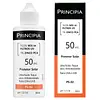What's inside
What's inside
 Key Ingredients
Key Ingredients

 Benefits
Benefits

 Concerns
Concerns

 Ingredients Side-by-side
Ingredients Side-by-side

Water
Skin ConditioningDisodium EDTA
Acrylates/C10-30 Alkyl Acrylate Crosspolymer
Emulsion StabilisingPropylene Glycol
HumectantPhenoxyethanol
PreservativeTocopheryl Acetate
AntioxidantSodium Hyaluronate
HumectantGlycerin
HumectantDMDM Hydantoin
PreservativeBisabolol
MaskingAlcohol
AntimicrobialDimethicone/Vinyl Dimethicone Crosspolymer
Skin ConditioningSilica
AbrasivePolymethyl Methacrylate
Dimethicone/PEG-10/15 Crosspolymer
Dimethicone
EmollientAminomethyl Propanol
BufferingEthylhexyl Methoxycinnamate
UV AbsorberButyl Methoxydibenzoylmethane
UV AbsorberOctocrylene
UV AbsorberButylene Glycol
HumectantLecithin
EmollientStyrene/Acrylates Copolymer
Water, Disodium EDTA, Acrylates/C10-30 Alkyl Acrylate Crosspolymer, Propylene Glycol, Phenoxyethanol, Tocopheryl Acetate, Sodium Hyaluronate, Glycerin, DMDM Hydantoin, Bisabolol, Alcohol, Dimethicone/Vinyl Dimethicone Crosspolymer, Silica, Polymethyl Methacrylate, Dimethicone/PEG-10/15 Crosspolymer, Dimethicone, Aminomethyl Propanol, Ethylhexyl Methoxycinnamate, Butyl Methoxydibenzoylmethane, Octocrylene, Butylene Glycol, Lecithin, Styrene/Acrylates Copolymer
Water
Skin ConditioningSodium Gluconate
Skin ConditioningXanthan Gum
EmulsifyingPropanediol
SolventAcrylates/C10-30 Alkyl Acrylate Crosspolymer
Emulsion StabilisingPhenylbenzimidazole Sulfonic Acid
UV AbsorberPotassium Cetyl Phosphate
EmulsifyingDisodium Cetearyl Sulfosuccinate
CleansingPolysorbate 60
EmulsifyingButyl Methoxydibenzoylmethane
UV AbsorberBis-Ethylhexyloxyphenol Methoxyphenyl Triazine
Skin ConditioningEthylhexyl Triazone
UV AbsorberEthylhexyl Salicylate
UV AbsorberDibutyl Adipate
EmollientCoco-Caprylate/Caprate
EmollientButylene Glycol Cocoate
EmulsifyingVp/Eicosene Copolymer
Tocopheryl Acetate
AntioxidantMethylene Bis-Benzotriazolyl Tetramethylbutylphenol
UV FilterPropylene Glycol
HumectantDecyl Glucoside
CleansingAluminum Starch Octenylsuccinate
AbsorbentSilica
AbrasiveZinc PCA
HumectantSodium Hydroxide
BufferingPhenoxyethanol
PreservativeCaprylyl Glycol
EmollientWater, Sodium Gluconate, Xanthan Gum, Propanediol, Acrylates/C10-30 Alkyl Acrylate Crosspolymer, Phenylbenzimidazole Sulfonic Acid, Potassium Cetyl Phosphate, Disodium Cetearyl Sulfosuccinate, Polysorbate 60, Butyl Methoxydibenzoylmethane, Bis-Ethylhexyloxyphenol Methoxyphenyl Triazine, Ethylhexyl Triazone, Ethylhexyl Salicylate, Dibutyl Adipate, Coco-Caprylate/Caprate, Butylene Glycol Cocoate, Vp/Eicosene Copolymer, Tocopheryl Acetate, Methylene Bis-Benzotriazolyl Tetramethylbutylphenol, Propylene Glycol, Decyl Glucoside, Aluminum Starch Octenylsuccinate, Silica, Zinc PCA, Sodium Hydroxide, Phenoxyethanol, Caprylyl Glycol
 Reviews
Reviews

Ingredients Explained
These ingredients are found in both products.
Ingredients higher up in an ingredient list are typically present in a larger amount.
Acrylates/C10-30 Alkyl Acrylate Crosspolymer is a synthetic polymer. It is used to thicken and improve the texture of products. Due to its properties, it can prevent water and oil ingredients from separating.
Also known as Avobenzone, this ingredient is a chemical sunscreen filter that provides protection in the UV-A range.
Avobenzone is globally approved and is the most commonly used UV-A filter in the world.
Studies have found that avobenzone becomes ineffective when exposed to UV light (it is not photostable; meaning that it breaks down in sunlight). Because of this, formulations that include avobenzone will usually contain stabilizers such as octocrylene.
However, some modern formulations (looking at you, EU!) are able to stabilize avobenzone by coating the molecules.
Avobenzone does not protect against the UV-B range, so it's important to check that the sunscreen you're using contains other UV filters that do!
The highest concentration of avobenzone permitted is 3% in the US, and 5% in the EU.
Learn more about Butyl MethoxydibenzoylmethanePhenoxyethanol is a preservative that has germicide, antimicrobial, and aromatic properties. Studies show that phenoxyethanol can prevent microbial growth. By itself, it has a scent that is similar to that of a rose.
It's often used in formulations along with Caprylyl Glycol to preserve the shelf life of products.
Propylene Glycol is an odorless, colorless liquid. As a humectant, it helps skin retain moisture. It also aids in delivering active ingredients.
Another role of this ingredient is preventing a product from melting or freezing. Propylene glycol also adds antimicrobrial properties to a product, elongating product lifespan.
This ingredient is considered an organic alcohol and commonly added into both cosmetics and foods.
Those with sensitive skin or conditions may develop a rash when using this ingredient.
Learn more about Propylene GlycolSilica, also known as silicon dioxide, is a naturally occurring mineral. It is used as a fine, spherical, and porous powder in cosmetics.
Though it has exfoliant properties, the function of silica varies depending on the product.
The unique structure of silica enhances the spreadability and adds smoothness, making it a great texture enhancer.
It is also used as an active carrier, emulsifier, and mattifier due to its ability to absorb excess oil.
In some products, tiny microneedles called spicules are made from silica or hydrolyzed sponge. When you rub them in, they lightly polish away dead skin layers and enhance the penetration of active ingredients.
Learn more about SilicaTocopheryl Acetate is AKA Vitamin E. It is an antioxidant and protects your skin from free radicals. Free radicals damage the skin by breaking down collagen.
One study found using Tocopheryl Acetate with Vitamin C decreased the number of sunburned cells.
Tocopheryl Acetate is commonly found in both skincare and dietary supplements.
Learn more about Tocopheryl AcetateWater. It's the most common cosmetic ingredient of all. You'll usually see it at the top of ingredient lists, meaning that it makes up the largest part of the product.
So why is it so popular? Water most often acts as a solvent - this means that it helps dissolve other ingredients into the formulation.
You'll also recognize water as that liquid we all need to stay alive. If you see this, drink a glass of water. Stay hydrated!
Learn more about Water